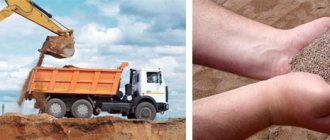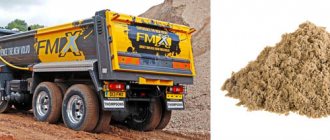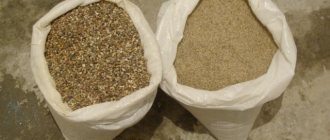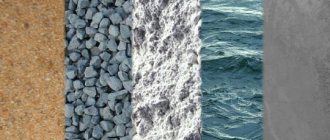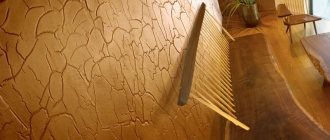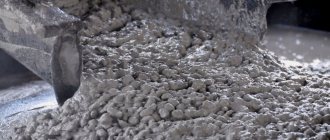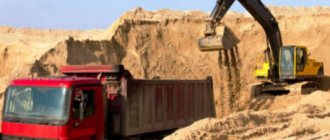A type of sand that is not differentiated by grain size is considered enriched. In addition, in addition to ordinary sand, it includes quartz, spar, gravel components, etc. Enriched sand is thoroughly cleaned of clay and particles of silt and black soil that accidentally get there by washing. Enriched sand is the most popular type of sand product: compared to conventional quarry or river sand, this building material is better than them not only in terms of cleaning quality, but also in terms of the parameters that are required from it.
Mining and enrichment
Based on the needs of a particular construction site, developers request sand of a specific grain size and cleaning quality. Not every region has the sand deposits needed to solve these needs, and delivery from neighboring regions will become more expensive. To eliminate such a problem, it is necessary to enrich the sand - the reagents that interfere with the quality and parametric indicators that got there “under their own power” are removed from it, and in return the material that is missing in volume and mass is introduced in order to fulfill the plan for the supply of such sand without deteriorating its properties.
The extraction process is staged:
- Having discovered sand deposits, after excavating it from the subsoil, the material is sorted into fractions, sifting out grains larger than 5 mm, using vibration shaking on a special device. When shaking, large particles tend to occupy the uppermost position in the layer of sand being processed, as a result they are easy to remove.
- What remains is cleaned of clay and other deposits using a wash tank, with a large amount of water passing through the sand, then the washed sand is dried by hot blowing.
- If washing the sand is impossible, it can be cleaned using the same blowing, but before that the batch of sand is rubbed to remove as much dirt as possible from the grains of sand. In this case, 100% cleansing is not possible; it is still preferable to wash the sand, otherwise it will not be considered a building material of the highest quality.
- Particles of quartz, crushed stone and stone screenings are introduced into the purified sand, which makes it possible to obtain enriched sand of good quality.
In the case of river sand, enrichment is carried out similarly. River enriched sand is obtained in a similar way. Large particles should not be introduced into fine- and medium-fraction sand - a narrow spread in particle size is carefully maintained.
Sand fineness modulus and its meaning
Fineness modulus (Mkr) is one of the most important characteristics of construction sand, based on an assessment of the size (diameter) of its constituent sand grains. According to GOST, this conventional value is the sum of the total residues of grains of various fractions on standard sieves, divided by 100.
Depending on the caliber of grains, sand used in construction is sorted as follows:
- Very thin - micron less than 0.7 mm;
- Thin - micron 0.7-1.0;
- Very small - microdistrict 1.0-1.5;
- Small - microdistrict 1.5-2.0;
- Average - microdistrict 2.0-2.5;
- Large - microdistrict 2.5-3.0;
- Increased size - micron 3.0-3.5;
- Very coarse sand - micron > 3.5 mm.
Method for determining the particle size modulus
To calculate this parameter, take a pre-dried portion of building material in the amount of 2 kg and successively sift through several sieves. The inventory with 10 mm cells is used first, followed by those with a diameter of 5 mm. In this way, large impurities, in particular gravel fragments, are separated. Finally, you need to shake the sieve over a white paper sheet - the first stage can be considered completed if there are practically no grains of sand on the sheet.
Then 1 kg of prepared sand is sifted through a set of standard sieves with a diameter of 2.5 to 0.14 mm, after which the result is assessed using mathematical operations. The permissible error of calculations is 0.1.
Why is sand coarseness important?
The volume of mixing water and the total consumption of binders when preparing the solution depend on how coarse the sand is used. Also, the fineness modulus, along with the degree of purity, is a factor that largely determines the quality and durability of the finished structure and underlies the recommendations of experts regarding the areas of use of sand in construction. If there are increased technical requirements, then alluvial sand will be needed (removed from unwanted impurities by thoroughly washing with plenty of water).
Sand in a concrete mixture is an essential component. Directly proportional to the increase in sand concentration, the viscosity of the prepared composition increases with a concomitant reduction in cement consumption. However, it should be borne in mind that too large a percentage of sand causes a decrease in the strength characteristics of the concrete structure.
Enterprises producing reinforced concrete concrete, paving slabs, curbs, rings for wells, as well as producing high-quality concrete, according to the standards, must use coarse and medium sand fractions. Small category material is in demand in the brick production process and for mixing cement mortars. Very thin and thin module are suitable options for preparing fine mixtures and coating solutions.
When sorting the most common sand of natural origin - mined in quarries - the particle size modulus, as a rule, is in the range from 1.5 to 4.5 mm. This sand is actively used for household work and for landscaping private and public areas. But if the material is purified to the required extent, then the following is also quite suitable:
- for the formation of foundations;
- for the construction of residential buildings;
- for use in road construction;
- for the construction of airfield sites.
The choice of sand size module is an important stage in planning construction work, in which it is necessary to take into account all the technical features of the task at hand.
beton24.ru
Why is sand enrichment necessary?
Enriched sand is mainly used directly in the construction of buildings and the construction of roads, paths, and platforms for various purposes. Enriched sand has good flowability, and structural elements built on its basis acquire very satisfactory strength. To make concrete for the same foundation or supporting base, coarse enriched sand is used, which makes it possible to maintain the strength of the resulting frame element, slab or block with less cement consumption.
For road construction, enriched sand better allows water to pass through the sides and drains it more efficiently, eliminating stagnation, which leads to waterlogging of the road base, the formation of mold and duckweed, which destroy any material. The road does not fall apart and the asphalt surface does not crack.
Terms and Definitions
The following terms with corresponding definitions are used in this standard:
3.1 sand: Natural inorganic bulk material with a grain size of up to 5 mm, formed as a result of the natural destruction of rocks and obtained during the development of boulder-gravel-sand, gravel-sand and sand deposits.
3.2 enriched sand: Natural inorganic bulk material with a grain size of up to 5 mm, with an improved grain composition and a lower content of dust and clay particles, obtained using special equipment.
3.3 fractionated sand: Natural inorganic bulk material divided into two or more fractions using special equipment.
Specifications
According to GOST (8736.1993/2014), the parameters of enriched sand include the following requirements:
- The grain size corresponds to the spread of values accepted in the calculus from particularly fine to particularly coarse values.
- The remainder on sieve No. 63 is no more than 1/20 of the total weight of the processed batch of sand;
- In terms of grain size, this sand belongs to class 1 (from very large to small grains of sand);
- Sand is resistant to alkalis (especially when preparing concrete based on it);
- There are no dirt particles in the enriched sand that deteriorate the quality of structures cast from such concrete, leading to premature crumbling of the plaster, etc.;
- The percentage of clay and silt in enriched sand is no more than 1/100 of the total amount;
- The maximum possible amount of clay and fine silt particles should not exceed 1% of the total volume;
- Color from light gray to light yellow;
- Bulk density 1.3…1.8 tons/m³.
The price for enriched sand compared to the same river or seeded quarry sand is significantly higher, but such costs are recouped with cement consumption that is much less than when using ordinary sand. The strength of erected concrete structures increases significantly - thanks to the coarser sand fraction. A material that is cleaner from foreign inclusions, having become the supporting basis for the object being built, will last much longer with constant maintenance, or the same amount - with much less frequent maintenance.
classification, assessment of sand quality – Southern Nonmetallic Company
Sand: sand classification
Depending on the percentage of large fragments in the sand, the following types of sand are distinguished: if 7-15% of the total mass of the rock is present, gravelly sands are distinguished, more than 15% are sand-gravel mixtures, with a significant content of silty or clayey material, respectively, silty or clayey sands.
Depending on the grain size, sands are classified into fine-, medium-, coarse- and different-grained.
Depending on the composition of the sand grains, the following types of sand are distinguished: monomineral sands, i.e. grains of one mineral predominate, oligomictic sands; two or three minerals are of primary importance, with one of them predominant. polymictic sands, i.e. There are grains of different composition.
Sand: sand quality assessment
Natural sand is a loose mixture of grains with a particle size of 0.16...5 mm, consisting mainly of quartz grains or an admixture of feldspars, mica, and limestone. Sands of other compositions, such as feldspathic and limestone, are less common. The bulk density of natural sand is 1300…1500 kg/m3.
By origin, natural sands are divided into: quarry, river and sea.
Quarry sands are formed as a result of the weathering of rocks and the subsequent transport of weathering products by wind and glaciers. The angular shape and rough surface of the grains contribute to their good adhesion to the binder. The disadvantage of quarry sands is that they are contaminated with clay and contain gravel.
River and sea sands are purer, but their grains tend to be round in shape as a result of prolonged exposure to moving water.
Artificial sands, used much less frequently, come in heavy and light varieties.
Assessment of sand quality based on fineness modulus.
Sand supplied for construction must meet the requirements of GOST 8736-93 and 8735-88 in terms of grain (particle-size) composition, presence of impurities and contaminants.
The grain composition of sand is determined using a standard set of sieves with mesh sizes: 5; 2.5; 1.25; 0.63; 0.315 and 0.16 mm.
Based on the results of sieve analysis, the sand fineness modulus is calculated: depending on the fineness modulus (Mk), sands are divided into groups by size. This is important to know because the finer the sand, the more water is needed to wet it (water requirement of sand), and binder to coat the surface of its particles.
SAND FINANCY MODULE
| Sand group | Indicators | |||
| standardized | non-standardized | |||
| Total residue on the sieve 0.65,% | Size modulus, Mk | Specific surface area, cm 2 /g | Passage through sieve 0.14,% by weight | |
| Large | More than 50 | More than 2.5 | — | Less than 10 |
| Average | 30-50 | 2,5-2,0 | — | Less than 10 |
| Small | 10-30 | 2,0-1,5 | 100-200 | Less than 15 |
| Very small | Less than 10 | 1,5-1,0 | 200-300 | Less than 20 |
The finer the sand, the smaller this value and, accordingly, vice versa. Sand with a fineness modulus of 1.5-2 is most often used for the production of bricks and mortars, the finest and rarest sand with a fineness modulus of only 0.8-1.2 is used for the production of dry building mixtures, and sand is used for concrete and reinforced concrete structures the particle size module of which is 2-2.5.
Sand: factors affecting sand quality
As you know, sand is used to prepare heavy concrete, which is widely used in almost all areas of construction. The properties of concrete, such as durability, strength and others, largely depend on the quality of the material used in the manufacture of concrete.
The quality of sand depends mainly on its grain composition and the content of harmful impurities in it. In heavy concrete, sand acts as a filler for the voids between the grains of coarse aggregate. At the same time, the voids between the grains of the sand itself are filled with so-called cement paste. Also, the surfaces of all particles should be covered with the same test. The grain composition of sand makes it possible to obtain concrete of a given grade with minimal consumption of cement paste. To achieve this goal, it is necessary to use sands with low voids and the smallest particle surface.
The grain composition of sand is determined by the content of grains of different sizes. Thanks to a standard set of sieves with holes through which a sample of sand is sifted and the composition of the sand is determined. According to the grain composition, sands can be divided into 4 groups: coarse, medium, fine and very fine.
The quality of sand is also affected by the content of harmful impurities in it (clay and dust particles, organic impurities, sulfur and sulfuric acid compounds). To obtain high-quality concrete, the amount of harmful impurities should not exceed the limits established by the standard.
Main advantages
Enriched sand is much more profitable than simple or purely quartz sand: the poured sand material can easily be stored in open space, but before packing and mixing sand into concrete, the water content in it must be checked. When delivering sand, the material itself goes through the necessary stages of monitoring its condition, right up to the time a particular batch reaches the customer’s construction site. Loss of strength after construction work is almost completely eliminated - there is no clay or other inclusions that spoil its composition in the sand.
Compared to ordinary sand, enriched sand, when transported in bags, is packaged in 25 or 50 kg bags, this makes it possible to bring it to the construction site in an uncontaminated state - even the penetration of road dust into the packaged sand is eliminated. Prices for packaged enriched sand as of 2020 are about 150 rubles. for 50 kg, the actual price depends on the delivery region and the specific company.
GOST 8736-93
Group Ж17 INTERSTATE STANDARD
Sand for construction work. Technical conditions
OKSTU 5711 Date of introduction 1995-07-01
Preface
1 DEVELOPED by the VNIPIIstromsyrye Institute with the participation of SoyuzDorNII, NIIZhB, TsNIIOMTP of the Russian Federation
INTRODUCED by the Ministry of Construction of Russia
2 ADOPTED by the Interstate Scientific and Technical Commission for Standardization and Technical Regulation in Construction (INTKS) on November 10, 1993.
The following voted for adoption:
| State name | Name of the state construction management body |
| The Republic of Azerbaijan | State Construction Committee of the Azerbaijan Republic |
| Republic of Armenia | Ministry of Urban Development of the Republic of Armenia |
| The Republic of Kazakhstan | Agency for Construction and Architectural and Urban Planning Control of the Ministry of Economy and Trade of the Republic of Kazakhstan |
| Kyrgyz Republic | Ministry of Architecture and Construction of the Kyrgyz Republic |
| Russian Federation | Gosstroy of Russia |
| The Republic of Tajikistan | State Construction Committee of the Republic of Tajikistan |
3 ENTERED INTO EFFECT on July 1, 1995 as a state standard of the Russian Federation by Resolution of the Ministry of Construction of Russia dated November 28, 1994 No. 18-29
5 INSTEAD GOST 8736-85, GOST 26193-84
Amendments No. 1, 2 have been introduced, approved by Resolutions of the State Construction Committee of Russia No. 18-17 of 02/18/98, No. 115 of 12/04/2000.
1 AREA OF USE
This standard applies to natural sand and sand from rock crushing screenings with a true grain density of 2.0 to 2.8 g/cm3, intended for use as a filler for heavy, light, fine-grained, cellular and silicate concrete, mortars, preparation dry mixtures for the construction of bases and coatings of highways and airfields. The requirements of this standard do not apply to graded and crushed sands. The requirements of this standard, set out in paragraphs 4.4.1, 4.4.3, 4.4.7, 4.4.8, sections 5 and 6, are mandatory.
2 REGULATORY REFERENCES
This standard uses references to the following standards. GOST 8269.0-97 Crushed stone and gravel from dense rocks and industrial waste for construction work. Methods of physical and mechanical tests. GOST 8735-88 Sand for construction work. Test methods. GOST 30108-94 Construction materials and products. Determination of specific effective activity of natural radionuclides
(Changed edition, Rev. 2)
3 DEFINITIONS
The following terms are used in this standard. Natural sand is an inorganic bulk material with a grain size of up to 5 mm, formed as a result of the natural destruction of rocks and obtained during the development of sand and sand-gravel deposits without or using special processing equipment. Crushed sand is sand with a grain size of up to 5 mm, made from rocks and gravel using special crushing and grinding equipment. Fractionated sand is sand that has been separated into two or more fractions using special equipment. Sand from crushing screenings is an inorganic bulk material with a grain size of up to 5 mm, obtained from rock crushing screenings during the production of crushed stone and from waste from the enrichment of ferrous and non-ferrous metal ores and non-metallic minerals and other industries.
(Changed edition, Amendment No. 1)
4 TECHNICAL REQUIREMENTS
4.1 Sand must be manufactured in accordance with the requirements of this standard according to technological documentation approved by the manufacturer. 4.2 Sand, depending on the values of standardized quality indicators (grain composition, content of dust and clay particles), is divided into two classes. 4.3 Basic parameters and dimensions 4.3.1 Depending on the grain composition, sand is divided into groups according to size: Class I - very coarse (sand from crushing screenings), increased size, large, medium and small; Class II - very coarse (sand from crushing screenings), increased coarseness, coarse, medium, fine, very fine, fine and very fine. 4.3.2 Each sand group is characterized by the particle size modulus value indicated in Table 1.
Table 1
| Sand group | Size module Mk |
| Very large | St. 3.5 |
| Increased size | >> 3.0 to 3.5 |
| Large | >> 2,5 >> 3,0 |
| Average | >> 2,0 >> 2,5 |
| Small | >> 1,5 >> 2,0 |
| Very small | >> 1,0 >> 1,5 |
| Thin | >> 0,7 >> 1,0 |
| Very thin | Up to 0.7 |
4.3.3 The total sand remaining on the sieve with mesh No. 063 must correspond to the values specified in Table 2.
Percentage by weight
Table 2
| Sand group | Full residue on sieve No. 063 |
| Very large | St. 75 |
| Increased size | >> 65 to 75 |
| Large | >> 45 >> 65 |
| Average | >> 30 >> 45 |
| Small | >> 10 >> 30 |
| Very small | To 10 |
| Thin | Not standardized |
| Very thin | >> >> |
Note - By agreement between the manufacturer and the consumer, in class II sand, the total residue on sieve No. 063 is allowed to deviate from the above, but not more than +/-5%.
4.3.4 Content of grains of fineness St. 10.5 and less than 0.16 mm should not exceed the values specified in Table 3.
Percentage by weight, not more than
Table 3
| Sand class and group | Grain size content | ||
| St. 10 mm | St. 5 mm | Less than 0.16mm | |
| I class | |||
| Extra fine, large and medium | 0,5 | 5 | 5 |
| Small | 0,5 | 5 | 10 |
| II class | |||
| Extra large and extra fine | 5 | 20 | 10 |
| Large and medium | 5 | 15 | 15 |
| Small and very small | 0,5 | 10 | 20 |
| Thin and very thin | Not allowed | Not standardized | |
4.4 Characteristics 4.4.1 The content of dust and clay particles in the sand, as well as clay in lumps, should not exceed the values specified in Table 4 .
Percentage by weight, not more than
Table 4
| Content of dust and clay particles | Clay content in lumps | |||
| Sand class and group | in natural sand | in sand from crushing screenings | in natural sand | in sand from crushing screenings |
| I class | ||||
| Very large | — | 3 | — | 0,35 |
| Extra fine, large and medium | 2 | 3 | 0,25 | 0,35 |
| Small | 3 | 5 | 0,35 | 0,50 |
| II class | ||||
| Very large | — | 10 | — | 2 |
| Extra fine, large and medium | 3 | 10 | 0,5 | 2 |
| Small and very small | 5 | 10 | 0,5 | 2 |
| Thin and very thin | 10 | Not standardized | 1,0 | 0,1* |
_____________ * For sands obtained from the enrichment of ores of ferrous and non-ferrous metals and non-metallic minerals from other industries.
Note - In very fine natural sand of class II, in agreement with the consumer, the content of dust and clay particles up to 7% by weight is allowed.
4.4.2 Sands from crushing screenings are divided into grades depending on the strength of rock and gravel.
Igneous and metamorphic rocks must have a compressive strength of at least 60 MPa, sedimentary rocks - at least 40 MPa. The grade of sand from crushing screenings must correspond in strength to that indicated in Table 5. Table 5
| Strength grade of sand from crushing screenings | Ultimate compressive strength of rock in a water-saturated state, MPa, not less | Gravel grade according to crushability in the cylinder |
| 1400 | 140 | — |
| 1200 | 120 | — |
| 1000 | 100 | Dr8 |
| 800 | 80 | Dr12 |
| 600 | 60 | Dr16 |
| 400 | 40 | Dr24 |
Note - It is allowed, by agreement between the manufacturer and the consumer, to supply class II sand from sedimentary rocks with a compressive strength of less than 40 MPa, but not less than 20 MPa.
4.4.3 Sand intended for use as a filler for concrete must be resistant to the chemical effects of cement alkalis. The durability of sand is determined by its mineralogical and petrographic composition and the content of harmful components and impurities. The list of rocks and minerals classified as harmful components and impurities and their maximum permissible content are given in Appendix A. 4.4.4 Sand from rock crushing screenings, having a true grain density of more than 2.8 g/cubic cm or containing grains of rocks and minerals classified as harmful components in quantities exceeding their permissible content, or containing several different harmful components, are produced for specific types of construction work according to technical documents developed in the prescribed manner and agreed upon with laboratories specialized in the field of corrosion. 4.4.5 It is allowed to supply a mixture of natural sand and sand from crushing screenings with a content of the latter of at least 20% by weight, and the quality of the mixture must meet the requirements of this standard for the quality of sand from crushing screenings. 4.4.6 The manufacturer must inform the consumer of the following characteristics established by geological exploration: - mineralogical and petrographic composition indicating rocks and minerals classified as harmful components and impurities; - emptiness; — content of organic impurities; — the true density of sand grains. 4.4.7 Natural sand, when treated with a solution of sodium hydroxide (colorimetric test for organic impurities according to GOST 8735), should not give the solution a color that matches or is darker than the color of the standard. 4.4.8 The sand must be given a radiation-hygienic assessment, based on the results of which the scope of its application is determined. Sand, depending on the values of the specific effective activity of natural radionuclides Aeff [1], is used: - at Aeff up to 370 Bq/kg - in newly constructed residential and public buildings; - at Aeff St. 370 to 740 Bq/kg - for road construction within the territory of settlements and areas of prospective development, as well as during the construction of industrial buildings and structures; - at Aeff St. 740 to 1500 Bq/kg - in road construction outside populated areas. If necessary, in national standards in force on the territory of the state, the value of the specific effective activity of natural radionuclides can be changed within the limits specified above.
(Changed edition, Amendment No. 1,2)
4.4.9 Sand should not contain foreign contaminants.
5 ACCEPTANCE RULES
5.1 Sand must be accepted by the technical control service of the manufacturer. 5.2 To verify compliance of sand quality with the requirements of this standard, acceptance and periodic tests are carried out. 5.3 Acceptance tests at the manufacturer are carried out daily by testing one replacement sample taken in accordance with GOST 8735 from each production line. During acceptance control, the following is determined: - grain composition; — content of dust and clay particles; — clay content in lumps. 5.4 During periodic testing of sand, the following is determined: - once a quarter - bulk density (bulk density at humidity during shipment is determined as necessary), as well as the presence of organic impurities (humic substances) in natural sand; - once a year and in each case of changes in the properties of the rock being mined - the true density of grains, the content of rocks and minerals classified as harmful components and impurities, the strength grade of sand from crushing screenings, the specific effective activity of natural radionuclides. Periodic monitoring of the specific effective activity of natural radionuclides is carried out in specialized laboratories duly accredited for the right to conduct gamma spectrometric tests or in radiation metric laboratories of supervisory authorities. In the absence of geological survey data on the radiation-hygienic assessment of the deposit and a conclusion on the class of sand, the manufacturer carries out a radiation-hygienic assessment of the mined rock sections using the express method directly at the mine face or in finished product warehouses (alluvium map) in accordance with the requirements of GOST 30108 .
5.5 Selection and preparation of sand samples for quality control at the manufacturing plant is carried out in accordance with the requirements of GOST 8735.
5.6 Delivery and acceptance of sand is carried out in batches. A batch is considered to be a quantity of material simultaneously supplied to one consumer in one train or in one vessel. When shipping by road, a batch is considered to be the amount of sand shipped to one consumer per day.
5.7 When checking the quality of sand, the consumer must apply the sampling procedure given in 5.8-5.11. If the results of the control check on the grain composition and the content of dust and clay particles are unsatisfactory, the batch of sand will not be accepted.
5.8 The number of spot samples taken to control the quality of sand in each batch, depending on the volume of the batch, must be at least:
| Batch size | Number of spot samples |
| Up to 350 m | 10 |
| St. 350 to 700 m | 15 |
| St. 700 m | 20 |
From the spot samples, a combined sample is formed that characterizes the controlled batch. Averaging, reduction and sample preparation are carried out according to GOST 8735.
5.9 To control the quality of sand shipped by rail, spot samples are taken when unloading wagons from the flow of sand on belt conveyors used to transport it to the consumer's warehouse. When unloading the car, five spot samples are taken at equal time intervals. The number of cars is determined taking into account the receipt of the required number of spot samples in accordance with 5.8. Cars are selected according to the instructions of the consumer. If the batch consists of one wagon, five spot samples are taken during unloading, from which a combined sample is obtained. If continuous transport is not used during unloading, spot samples are taken directly from the cars. To do this, the surface of the sand in the car is leveled and holes 0.2-0.4 m deep are dug at the sampling points. The sampling points should be located in the center and in the four corners of the car, and the distance from the sides of the car to the sampling points should be not less than 0.5 m. Samples are taken from the holes with a scoop, moving it from bottom to top along the walls of the hole.
5.10 To control the quality of sand supplied by water transport, spot samples are taken when unloading ships. When belt conveyors are used for unloading, spot samples are taken at regular intervals from the sand flow on the conveyors. When unloading a vessel with grab cranes, point samples are taken with a scoop at regular intervals as unloading proceeds, directly from the newly formed sand surface in the vessel, and not from the holes. For control testing of sand unloaded from ships and placed on alluvial maps using hydromechanization, spot samples are taken in accordance with 2.9 of GOST 8735.
5.11. To control the quality of sand shipped by road, spot samples are taken when unloading vehicles. If belt conveyors are used for unloading sand, point samples are taken from the flow of sand on the conveyors. When unloading each vehicle, one spot sample is taken. The number of cars is determined taking into account the receipt of the required number of spot samples according to 5.8. Cars are selected according to the consumer's instructions.
If the lot consists of less than ten cars, sand samples are taken from each car. If conveyor transport is not used when unloading cars, spot samples are taken directly from the cars. To do this, the surface of the sand in the car is leveled, a hole 0.2-0.4 m deep is dug in the center of the body. Sand samples are taken from the hole with a scoop, moving it from bottom to top along the wall of the hole.
5.12 The amount of sand supplied is determined by volume or weight. Sand measurements are carried out in wagons, ships or cars. Sand shipped in wagons or cars is weighed on truck scales. The mass of sand shipped in ships is determined by the vessel's draft. The amount of sand from units of mass to units of volume is recalculated based on the bulk density of sand, determined by its moisture content during shipment. The supply contract specifies the calculated sand moisture content accepted by agreement of the parties.
5.13 The manufacturer is obliged to accompany each batch of supplied sand with a document on its quality in the established form, which must indicate: - the name of the manufacturer and its address; — number and date of issue of the document; — batch number and amount of sand; - numbers of wagons and vessel number, invoice numbers; — class, fineness module, total residue on sieve No. 063; — content of dust and clay particles, as well as clay in lumps; — specific effective activity of natural radionuclides in sand in accordance with 5.4; — content of harmful components and impurities; — designation of this standard.
6 CONTROL METHODS
6.1 Sand tests are carried out in accordance with GOST 8735. 6.2. The specific effective activity of natural radionuclides in sand is determined according to GOST 30108.
7 TRANSPORTATION AND STORAGE
7.1 Sand is transported in open railway cars and ships, as well as cars in accordance with the rules for the carriage of goods by the appropriate mode of transport approved in the established manner and stored in the warehouse of the manufacturer and consumer under conditions that protect the sand from contamination. When transporting sand by rail, compliance with the requirements of the Technical Conditions for Loading and Securing Cargo, approved by the Ministry of Railways, must also be ensured. 7.2 When shipping and storing sand in winter, the manufacturer must take measures to prevent freezing (shovelling, treatment with special solutions, etc.).
APPENDIX A (required)
CONTENT OF HARMFUL IMPURITIES
The permissible content of rocks and minerals classified as harmful components and impurities in sand used as a filler for concrete and mortars should not exceed the following values: - amorphous varieties of silicon dioxide, soluble in alkalis (chalcedony, opal, flint, etc.) - no more than 50 mmol/l; - sulfur, sulfides, except pyrite (marcasite, pyrrhotite, etc.) and sulfates (gypsum, anhydrite, etc.) in terms of SO(3) - no more than 1.0%; pyrite in terms of SO(3) - no more than 4% by weight; — mica — no more than 2% by weight; - halide compounds (halite, sylvite, etc.), including water-soluble chlorides, in terms of chlorine ion - no more than 0.15% by weight; — coal — no more than 1% by weight; - organic impurities (humic acids) - less than the amount that gives the sodium hydroxide solution (colorimetric test according to GOST 8267) a color corresponding to the color of the standard or darker than this color. The use of sand that does not meet this requirement is permitted only after positive results have been obtained from tests of sand in concrete or mortar for durability characteristics. The permissible content of zeolite, graphite, and oil shale is established based on studies of the effect of sand on the durability of concrete or mortar.
APPENDIX B Deleted
(Changed edition, Rev. 2)
Guarantees
Some companies, trying to earn more, present for sale as enriched sand an ordinary “different grain” that has not undergone additional purification or has passed through, but is not really enriched (or under-enriched). To avoid falling for such fraud, use sand delivery from companies that closely cooperate with quarry miners - they will definitely not allow inconsistencies, because sand is enriched at the site of its extraction.
Each such organization or company must provide a quality certificate issued based on an assessment based on the results of laboratory tests. Development companies, which have hundreds of successfully constructed high-rise buildings, collect copies of these certificates and keep them - if necessary, read their reviews and make sure that these documents are not forged.
